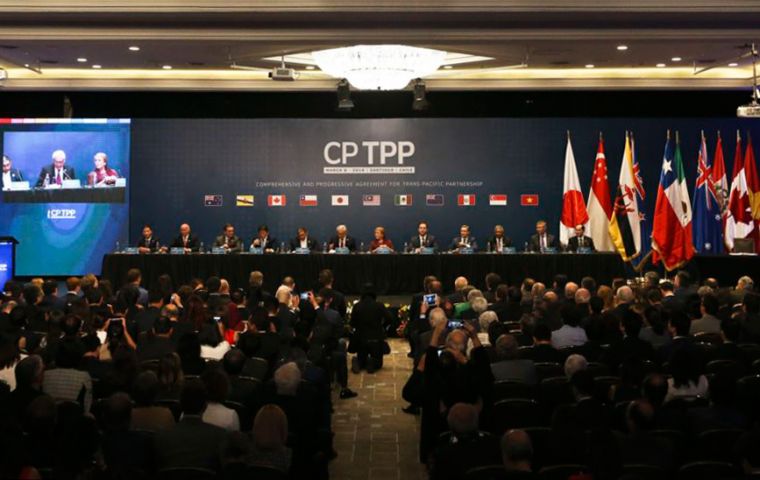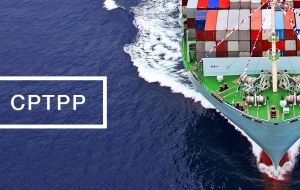MercoPress. South Atlantic News Agency
Eleven Asia-Pacific countries signed a Trans-Pacific Partnership in Chile
 In the absence of the US, it has been renamed the Comprehensive and Progressive Agreement for Trans-Pacific Partnership (CPTPP).
In the absence of the US, it has been renamed the Comprehensive and Progressive Agreement for Trans-Pacific Partnership (CPTPP).  The trade deal main purpose is to slash trade tariffs between member countries, but it also seeks to reduce so-called non-tariff measures, which create obstacles to trade
The trade deal main purpose is to slash trade tariffs between member countries, but it also seeks to reduce so-called non-tariff measures, which create obstacles to trade Eleven Asia-Pacific countries have just signed the trade pact formerly known as the Trans-Pacific Partnership. Although the US pulled out last year, the deal was salvaged by the remaining members, who signed it at a ceremony in the Chilean city of Santiago.
Chilean foreign minister Heraldo Munoz said the agreement was a strong signal “against protectionist pressures, in favor of a world open to trade”. The deal covers a market of nearly 500 million people, despite the US pullout.
In the absence of the US, it has been renamed the Comprehensive and Progressive Agreement for Trans-Pacific Partnership (CPTPP).
Extraneous adjectives aside, its supporters say it's hugely significant, and could be a model for future trade deals. Its main purpose is to slash trade tariffs between member countries. But it also seeks to reduce so-called non-tariff measures, which create obstacles to trade through regulations.
There are chapters which aim to harmonize these regulations, or at least make them transparent and fair. There are also commitments to enforce minimum labor and environmental standards.
It also includes a controversial Investor-State Dispute Settlement mechanism, which allows companies to sue governments when they believe a change in law has affected their profits.
Members in alphabetical order include: Australia, Brunei, Canada, Chile, Japan, Malaysia, Mexico, New Zealand, Peru, Singapore and Vietnam.
The US is conspicuously absent. President Donald Trump fulfilled an election promise by pulling out in January last year, labeling the deal a disaster for American workers.
In short, the biggest winners are expected to be in Asia, while the wealthier countries, on balance, are not expected to receive as much of a boost. The Peterson Institute for International Economics says Malaysia, Singapore, Brunei and Vietnam will each receive a bump of more than 2% to their economy by 2030. New Zealand, Japan, Canada, Mexico, Chile and Australia will all grow by an additional 1% or less.
The remaining nations' economies account for more than 13% of the global economy - a total of $10 trillion dollars. With the US, the deal would have represented 40%.
Australia's Prime Minister, Malcolm Turnbull, says the deal has been set up to allow it to admit new members, possibly including the US.


![“Working directly with President [Donald] Trump and Congress, we accomplished what no one else could,” Patel stressed](/data/cache/noticias/108417/130x80/fbi.jpg)

Top Comments
Disclaimer & comment rules-

-

-

Read all commentsYou joke, but why not?
Mar 10th, 2018 - 01:20 pm +1Free trade works and has helped to make my country a very rich and prosperous place.
Hopefully we attract more international students, visitors and immigrants from Chile, Peru and Mexico as these new links deepen. Colombia is the only Pacific Alliance member not in this new TPP.... hopefully not for long.
What about Guatemala, El Salvador, Costa Rica, Panama(very important), Colombia and Ecuador? And surely Bolivia could be squeezed in somewhere?
Mar 09th, 2018 - 06:24 pm 0It is worth noting the absence of so many nations from both PA and the TPP? What is their motive?
Mar 10th, 2018 - 01:46 pm 0Commenting for this story is now closed.
If you have a Facebook account, become a fan and comment on our Facebook Page!